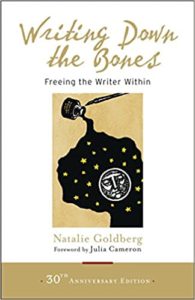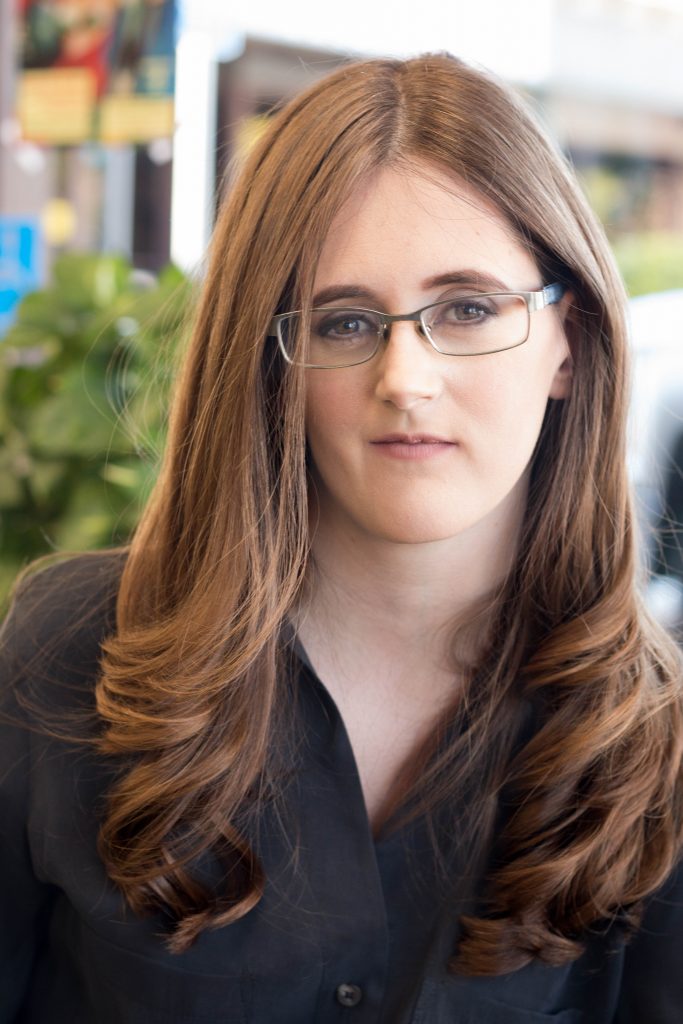By Marissa Dunham //

Writing Down the Bones: Freeing the Writer Within by Natalie Goldberg
Last month, I reviewed a book on craft by a prolific fantasy author, Ursula K. Le Guin. But there are craft books that are favorites all on their own.
You may be reading this review because you want to re-live a book that inspired you. Maybe after this, you’ll dust off the cover and read Writing Down the Bones one more time. You may find that you have forgotten how much you loved the book and you’re remembering all the parts that made you smile. Or, maybe you’re here seeking a recommendation for a craft book and have stumbled upon this review in the hope of finding something different to read. Or, perhaps you’ve been curious about Writing Down the Bones for a long time. You’re reading the title on the spine, wondering if now is the time. After all Writing Down the Bones has been around for over 30 years and a lot of people love it. Surely, it’s got to be good?
Writing Down the Bones is a book of writerly inspiration. Natalie Goldberg combines writing practice with mindset meditations from Zen Buddhism.
What Goldberg gives writers is permission to be messy.
You must have heard of the terrible first draft. But how far have you actually gone with it?
C.S. Lewis threw his early draft of the Narnia series in the fire after putting everything he had on the page. Now, what Lewis was doing was more an act of letting go than a sign he should have planned ahead better for his first drafts. But, like Lewis, we have to write the terrible draft (and maybe symbolically destroy the first couple) in order to get to those rich scenes and finished stories. As Richard Bausch, a mentor and friend, has told me many times, you cannot permanently damage a story. It might not look the way you wrote it at the start, but you can’t actually do irreparable harm by writing it. Sylvia Plath, too, wrote this way.
Ted Hughes, in The Collected Poems of Sylvia Plath, wrote “…if she couldn’t get a table out of the material, she was quite happy to get a chair, or even a toy.”
Writing without judgment is why we practice. So the noise eventually quiets enough for the material we need for rewriting to begin. And no one teaches this with more delight than Goldberg in her book Writing Down the Bones.
What are the bones?
The bones of the book, the book’s structure, is loose. The book is 180 pages and over 60 chapters, not including any forewords or afterword. The chapters are at most one to two pages long and aren’t numbered. They tell stories of workshops Goldberg has held, mistakes she has made as a writer, and writers she has met along the way.
“Learning to write is not a linear process,” writes Goldberg in the “Introduction” and neither is this book. After reading the book from cover to cover the first time, chapters can be read at random and can be great moments of inspiration for warm-ups.
The “bones” in the title refer to “the essential, awake speech of [the] mind” on page 4 of the “Introduction.”
For advanced writers, you may find this book to be light. The read won’t be valueless, but you’ve probably heard many of the lessons before.
The book might be for you if:
- Journaling is part of your writing practice
- You’re curious
- You’ve felt for a while that there is something missing in your writing routine, but you’re never sure what
Beyond reading Writing Down the Bones, have you thought about taking an actual workshop with Goldberg? With distance learning available, opportunities for writers to explore have opened up more now than ever before.
Writing Down the Bones is a book that charms. Goldberg gives readers permission to tap into their fertile creativity because she’s been on this path before. She wrote terrible first drafts, found comfort in writing every day, and took it one day at a time to eventually write 14 other books. The openness with which she writes makes her seem like you’d want to share a cup with her at a booth in a café and spend hours talking with her about writing and life. Reach out. Communicate, she says. Find yourself writing something completely crazy after this book on the writer’s life and see what makes it a treasure to many after more than 30 years.
Marissa’s Take Writing Practice Exercise*: List word phrases that start with “A” and “F.” Write for five minutes.
Example: Adverb Fiend. Ask First. Arrive Finished.
*Exercise inspired by Sarah Selecky, who learned a version from Bret Anthony Johnston.

MARISSA DUNHAM is a writer and freelance editor. She spent the early part of her career in educational publishing, but now spends most of her time editing literary fiction, magical realism, and middle grade fiction. She lives in Southern California, where she enjoys bringing new life into the world by planting tomatoes and flowers in the garden.


Marissa–Wow! I didn’t realize that Lewis had torched his early draft of Narnia works (only to have them rise in a better form!). I enjoyed your well-written and informative blog!